CALIFORNIA NATIVE PLANT SOCIETY
Channel Islands Chapter
Channel Islands Chapter
Rare Plant Profiles:  Eriogonum clavatum
Eriogonum clavatum
 Eriogonum clavatum
Eriogonum clavatum
Eriogonum clavatum Small [E. trichopes var. hooveri, E. hooveri, E. trichopes ssp. clavatum], Hoover's (Little Trumpet) Buckwheat, is a late spring to summer flowering annual forb in the Polygonaceae (Knotweed family) with tiny yellow flowers and reddish-brown, inflated and hollow stems. It grows to approximately 1 m high from a single stem with a rosette of basal leaves. The stems are green, turning reddish brown as they age. The inflorescence is dichotomously branched, in open umbels upon umbels, with tiny yellow-petaled flowers. The pedicels are quite thin. Flowering year-round.
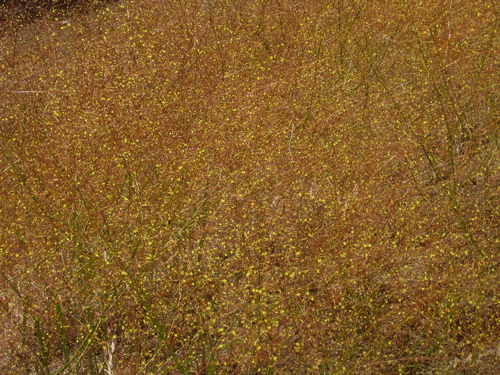
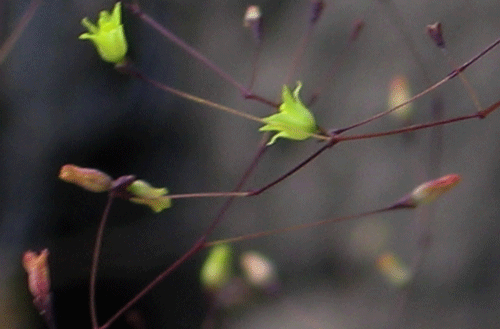
Technical Description
Herbs, erect, annual, (2-)4-18(-22) dm, glabrous, bright green. Stems: caudex absent; aerial flowering stems erect, hollow and fistulose, 0.5-3.5(-5) dm, glabrous, minutely glandular proximally, infrequently also short-hispid. Leaves basal; petiole 1-6 cm, hirsute; blade round to reniform, (0.5-)1-2.5(-4) × (0.5-)1-2(-3) cm, short-hirsute on both surfaces and greenish, margins plane. Inflorescences cymose, open, spreading to erect, 30-150(-170) × 10-80 cm; branches usually fistulose, glabrous; bracts 3, scalelike, 1-4 × 1-2 mm. Peduncles mostly spreading, straight, slightly bent distally, capillary, 1-4 cm, glabrous. Involucres turbinate, 1-1.5(-1.8) × 0.6-0.9(-1.2) mm, glabrous; teeth 4, erect, 0.3-0.5 mm. Flowers 1.5-2.5 mm; perianth yellow with greenish to reddish midribs, densely hirsute with coarse curved hairs; tepals monomorphic, narrowly ovate; stamens exserted, 0.9-1.5 mm; filaments glabrous or sparsely pubescent proximally. Achenes light brown to brown, 3-gonous, 2-2.5 mm, glabrous.
Eriogonum clavatum is the tall, slender member of the E. inflatum complex.
Habitat
Eriogonum clavatum grows primarily on heavy, clayey soils. It is usually found in open areas, including ruderal and naturally disturbed habitats, on flats and slopes in mixed grassland, chaparral, saltbush, and sagebrush communities, and in oak and montane conifer woodlands. It ranges in elevation from 400 to 1,100 m. Eriogonum clavatum is associated with various species, depending upon where it is growing. In Ventura County is it associated with Acanthomintha obovata, Allium howellii, Layia heterotricha, Chrysothamnus nauseosus/Ericameria nauseosa, and Pinus monophylla.
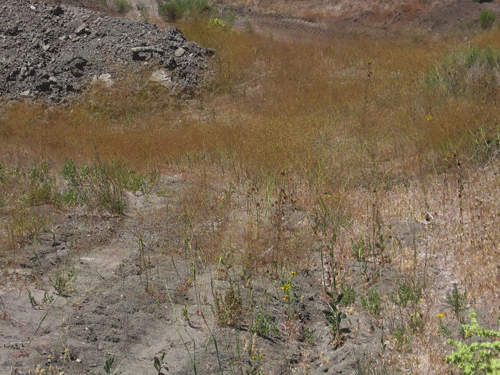
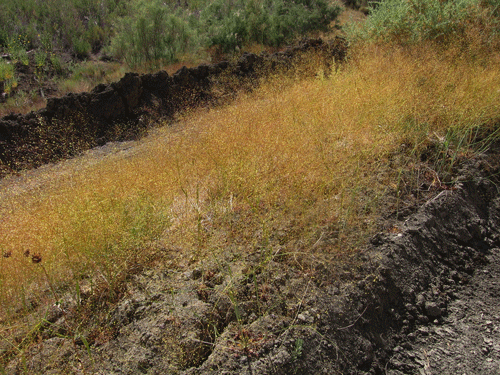
Distribution/Range
Eriogonum clavatum ranges from central-western California south and eastward to Nevada, and south to Mexico (Baja California). In California it occurs from Monterey-San Benito-Fresno Counties in the north south along the Inner South Coast Ranges to San Luis Obispo and Kern Counties, and in the northern Western Transverse Ranges of Ventura and Los Angeles Counties. A total of 62 voucher specimens have been deposited in one or more public California herbaria, representing a total of approximately 43 distinct populations:
- 7 in western Fresno County;
- ~12 in Kern County;
- 7 in northwestern Los Angeles County;
- 3 in southeastern Monterey County;
- 2 in southeastern San Benito County;
- 5 in southeastern San Luis Obispo County; and
- 7 in northern Ventura County.
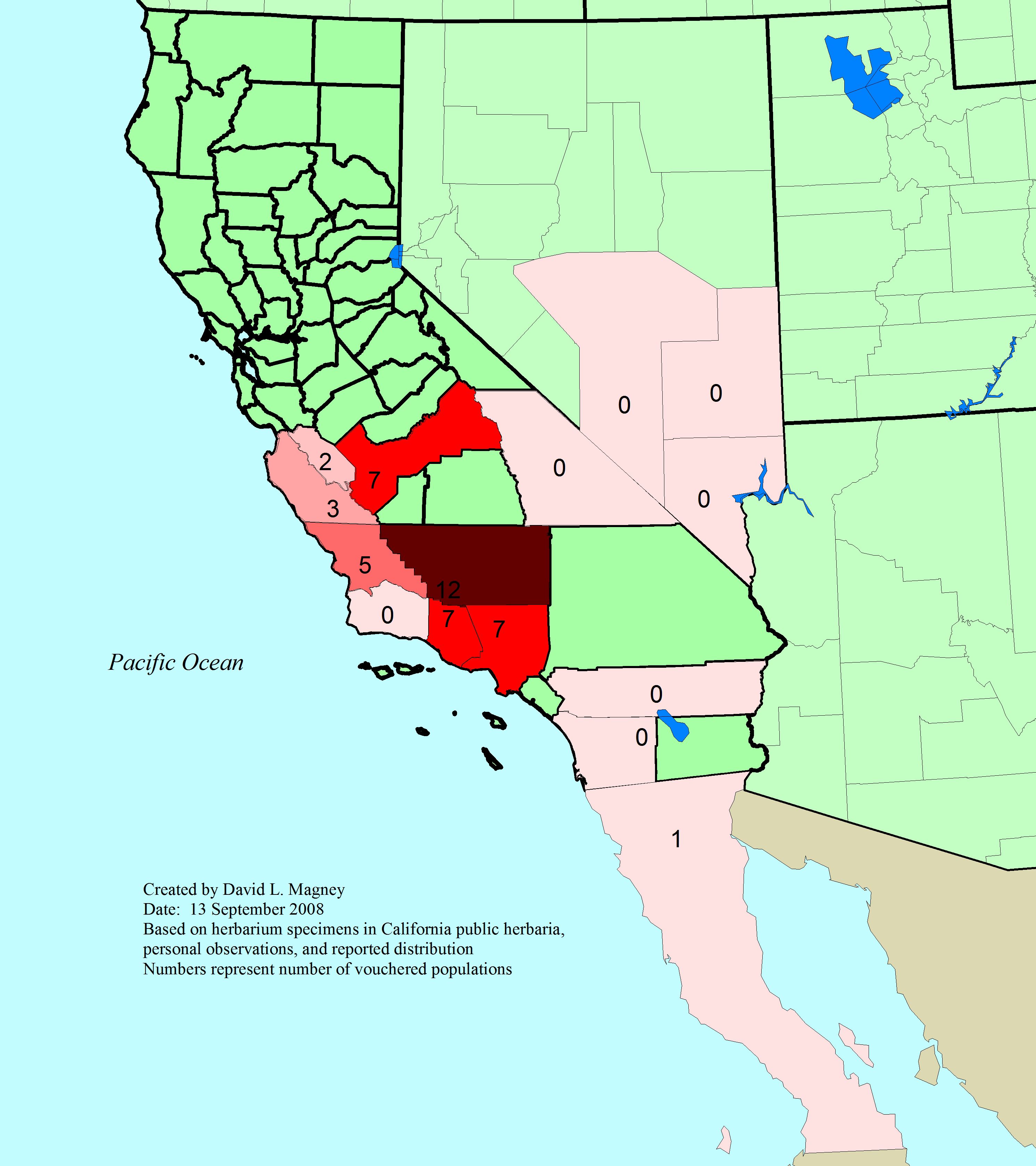
Rarity Status/Rankings
NatureServe (in 2000) assigned a global rarity ranking for Eriogonum clavatum; however, the ranking needs to be re-evaluated since the number of known and documented occurrences/populations does not support the assigned global ranking, and was based on when it was considered a subspecies rather then a full species.
- G5T4? = Apparently secure (on the order of more than 120 occurrences, of no immediate conservation concern) globally.
- N? = Not ranked Nationally, but should be the same as the global rank.
- S? = Not ranked for California, but should be the same as the global rank.
- CNPS List ? (not yet considered); however, it meets the listing criteria for List 1B, Plants rare and endangered in California and elsewhere.
- CNPSCI List VC Uncommon (6 to 10 populations within Ventura County).
CHANNEL ISLANDS CHAPTER, CALIFORNIA NATIVE PLANT SOCIETY, PO Box 6, Ojai, CA 93024-0006
Special thanks to Carlin Moyer for the beautiful illustrations on our site. Photographs and maps are courtesy David Magney.
Created: 12 September 2008; Last updated: 12 September 2008
For website comments: webmaster(at)cnpsci(dot)org
For website comments: webmaster(at)cnpsci(dot)org
CNPS HOME | SITE MAP | CHANNEL ISLANDS CHAPTER HOME